Marrakech / In two-and-a-half days
- Sheryl

- Mar 20, 2020
- 8 min read
Updated: Aug 27, 2020
A first-timer's two-and-a-half-day travel itinerary and photo journal through Marrakech.

It was not the array of pastries and flatbreads, the mint tea, or the orange juice in the breakfast buffet that drove away all my grogginess. It was the dry, wintry air that chilled us to the bone- that left a group of students doing a weird jumpy dance outside the lobby as we waited.
The sun had not fully risen from its slumber. And yet, its strength was hinted at by shards of blinding light that shone through the palm leaves along the 30-minute walk from our hotel to the Medina. The city was still - interrupted only by the occasional motorcyclist - as we shuffled through the sharp cold. The Koutoubia Mosque rose ahead of us- grand, welcoming, as we made our way up to the Le Grand Balcon du Café Glacier for a briefing while we watched vendors setting up in the square and warmed our souls with more mint tea. Excitement hung in the air as we stared across a still very vacant Djemaa El-Fna: the gateway to the Marrakech Medina.
d a y 1
- The Medina -
The Old City- the heart of Marrakech.
A vibrant, living ochre maze full of extremities :
of old and new,
of poverty and luxury.
The Medina is a UNESCO World Heritage site, and the heart of Marrakech's culture- a MUST visit for any first-timer.
There are two main areas:
the Southern area for palaces and fine architecture; and the Northern area for shopping in the souks.
We... just went in and quite literally got lost with only the Koutoubia Mosque minaret as our marker. Alternatively, you could also book a guided Medina tour.
Jemaa el-Fna
A stage. A performer. A gateway.
This is the starting point for all adventures in the Medina. A UNESCO heritage site, this square is known as a 'living culture' of the people. It transforms from day to night: from market stalls to snake charmers, monkey trainers, performers, to a bustling night food market.
Eats /
The square is surrounded by restaurants and cafes, where you can watch the transformation of the Jemaa el-Fna from the many restaurant balconies.
However, most of them are very overpriced for mediocre food.
I recommend having a drink at these restaurants (most of them will require you to order something to use the balcony), then save your stomach for a meal in the many pretty restaurants within the Medina.
Or if you're an adventurous foodie, the Jemaa el-Fna is also very well-known for Moroccan street food.
What started off as a peaceful vacant land in the morning had transformed into a bustling square as people hooted and cheered in the late afternoon sun.
I liked the peace in the morning, but in all honesty, I found it odd to be staring at it in the late afternoon when the crowds peaked. For one, I am not a fan of crowds- whether it was trying not to step on the cobras on the ground, or fighting for views amongst the tourists on the balcony.
And I found it unsettling that people were down in the square yelling for customers, exploiting animals for entertainment, while I was just at a cafe balcony, staring down at them like a circus. I did not like the way that felt. The Jemaa el-Fna itself though, is a square rich in culture and history. And the way it was portrayed was still, a very interesting experience that I think first-timers should see for themselves.
m o r n i n g
- The Southern Medina -
The souks of the Northern Medina were still not yet open, so we ventured first to the area south of the Jemaa el-Fna - where elaborate palaces and tombs of the Saadi Dynasty stood. This is where you find architectural wonders of extreme intricacy in every detail from the Saadian Tombs, to the vast courtyards of the El Badi Palace, the chromatic geometries of the Jewish Cemeteries and the decorative gateway of the Bab Agnaou.
This is also where many tourists would block your view of it all so come early.
The Saadian Tombs


It was 9am: the morning was an uneventful one as the dusty, vacant lanes of the Medina gave way to a hidden enclave of Moroccan architectural wonder. An open courtyard serenaded by the chirping of birds; colourful tiled lanes; the weight of the rich history the tombs have to tell hung in the air, silencing everyone to hushed awe. These beautiful, extremely intricate tombs date all the way back to 1500s and were only rediscovered in the 1900s.
*Reality Check: Wooooowww ~ Ugh dude please get out of my photo??*
And that is why I highly recommend visiting early.
The El Badi Palace


We walked through the ruins of a palace that hinted at a magnificence that may have once been so. A curious palace it was: small doorways - some so short you had to bend over to cross - led to towering earthen walls filled with crevices whispering of the splendour of the Saadian Empire of old.
All that was left of the palace was ruins- but it certainly lived up to its history of being once, the most splendid palace in Morocco. We stepped out of the maze of walls to a vast courtyard consisting of 4 big sunken orange tree orchards delineated by a long, still pool. This was a far cry from the intricacies of the Saadian Tomb, but there was a poetic sense of sanctity to the palace. The ruined structures surrounding the sprawling courtyards were like its guardians: loyal sentries that stood strong despite the wearing of time to guard the memory of its splendour that sunk but never sank.
Bab Agnaou

An intricately-carved gate not very conveniently located by a busy road. It was really hard to get a full picture without cars or people photo-bombing.
a f t e r n o o n
- The Souks -

Dusty. Narrow. Labyrinthian.
North of the Jemaa El-Fna lay the souks: a world away from the peace and serenity of the south. The air was clouded with dust dancing in the sun. Here, rough, dirty, adobe walls served their primary purposes of survival and shelter. The buildings had a 21m height restriction for the protected view of the Koutoubia Minaret.
I found it curious that for the rich, colour and art lay in the architecture, achieved by hiring artisans; but here, the art lay in the skills of the people: in embroidered handicrafts and jewellery that adorned the plain walls of the souks.
It was quite an immersive experience. There were so many things to see: architecturally, the signature pink adobe walls were never-ending. Look up and you would sometimes see timber shafts, to net shelters, to the Koutoubia Minaret. Look around, and I was very distracted by sacks of spices, the many beautiful cushion covers, rugs and (my ultimate weakness) beaded earrings.
All the while, vendors were trying to get our attention: some inviting, some friendly, some gruff, and some bidding 'Hello' in every single Asian language they could think of. Not to mention, we had to weave through the crowds and motorcyclists in the narrow lanes while taking pictures or shopping.
It was a maze of doorways : some led to dark alleys and construction debris. While some unassuming doors led to amazing Riad resorts and posh restaurants. It was a gamble for us. But we did chance upon some very nice interior design shops.
My personal favourite route was the Souk Semmarine: a lane filled with cushion covers, rugs, carpets, pouches, and a collection of beaded earrings that I thought were more exciting than the ubiquitous racks seen everywhere else in the Medina!
I found this guide that has a comprehensive summary of navigating through the souks.
The Koutoubia Mosque

The Northern star that welcomed us in the early break of day, the guide that saw us through the maze of the olden twisting streets, and once again, the monument that bade us goodbye as we left the old city behind.
dinner /
Or stay for a nice rooftop candlelit dinner at Nomad.

On the menu : A modern twist to the local cuisine. The Moroccan Date Cake was the perfect ending to the evening.
d a y 2
We took a day trip to Ait -Benhaddou.
Check out my photo journal of that experience here!
d a y 3 / m o r n i n g
- Ville Nouvelle -
It was clean and pristine. Shops had proper window displays.
Buildings stood tall, straight, modern. The streets were wide, with proper signage.
It was as if, the Medina had been a dream, the Ville Nouvelle reality of the present-
for how could such contrasts exist within one city?
The Ville Nouvelle is located in the Gueliz region: the modern commercial hub of Marrakech that enveloped the Medina. This is where you find the usual shops like H&M and Zara. It was a refreshing change of view from the claustrophobic streets of the Souks, but other than the Ville Nouvelle, I found the Medina a lot more interesting than the Gueliz area.
The YSL Museum
The signature brick facade was a testament to the local architecture. A museum that I thoroughly enjoyed : one that narrated the life of Yves Saint Laurent, as well as a display of his works that was inspired by his travels.
Le Jardin Majorelle
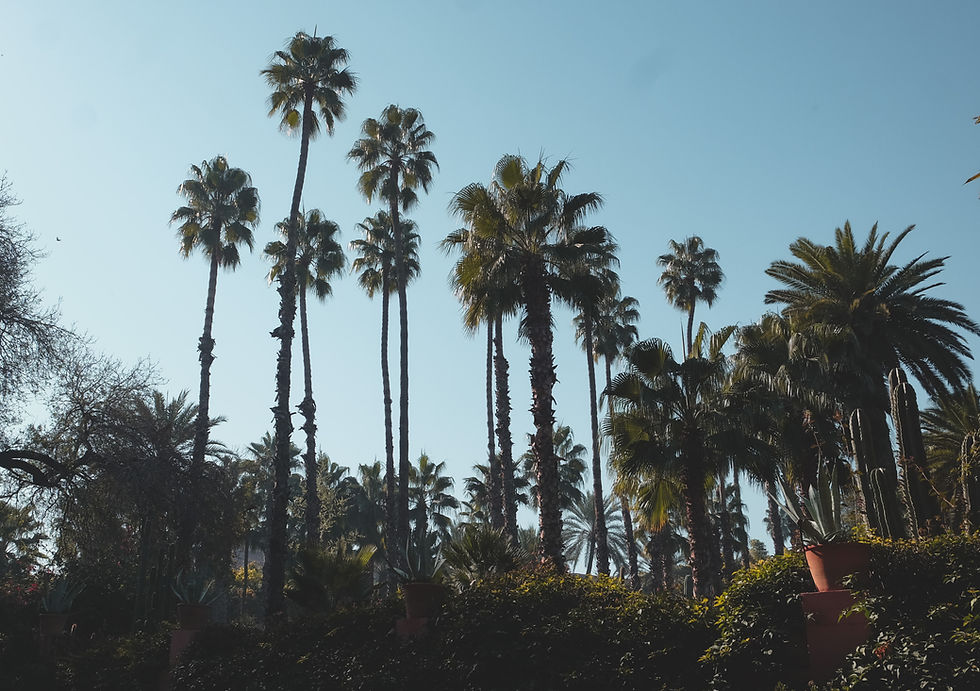
Miami vibes? I assure you, it was merely the entrance to Le Jardin Majorelle.
An artist's passion.
The YSL Museum opened to a sprawling garden filled with a variety of plants. We entered via the bamboo garden- the visible sun rays filtering through the dense plantation complementing the calmness that only bamboo plantations could exude.
On the journey, we encountered ponds, a variety of cacti (some menacing, some cute), ferns of all colours and sizes, majestic palms and bright flowers. The gardens gradually revealed a building of Art Deco charm.
The essence of the artist really came through in the bold choice of colours: from the bright orange flowers to the intense, deep blue of the building and bright yellow urns. This was also where the unseen crowd the garden hid gathered for that perfect Instagram picture. Where we too, fought our way through for photos before relenting to the rumbling of our stomachs desperate for lunch.
lunch /
MyKawa, a casual salad bar / European cafe.
On the Menu : simple but good quiche and ice cream to combat the heat!
p r e - d e p a r t u r e
We rushed back to the souks for some last-minute shopping. And that was, sadly, when we just discovered our favourite shopping area: Souk Semmarine, a heaven for interior designers.
lunch /
And with a last lunch in the beautiful Cafe Arabe nearby, off we ran. Back to the hotel to pack our precious new finds and return to the grey city of London.

On the menu : a Moroccan and Italian menu. I actually had the best Couscous Sept Légumes (vegetable couscous) here.
- Travel tips, thoughts & stories inspired -
Marrakech or The Red City is a vibrant city of extremities in culture and life, and hence, the contrasting reviews. On one hand, I was warned of horrible taxi drivers and pickpockets (be careful of them if you ever visit!). On the other hand, fabulous Instagram pictures of magnificent interiors and the vibrant culture of Morocco as talked about in various travel blogs left me fascinated and curious.
Yes, the city was extremely dusty and I left with my BLACK jeans and sports shoes GREY.
The people were generally pretty friendly, but I did have a couple of unpleasant encounters in the Medina: of harsh locals threatening to take away my camera; of very persistent shopkeepers who refused to leave me alone despite my many refusals; of unfriendly crowds, and of annoying men who were checking out my very tall and pretty friend for her slightly form-fitting dress.
But despite it all, I loved the trip. It was a city filled with stories, a city so rich in culture where the old and new are equally celebrated, where dusty debris and pristine corners are unified to form the narrative that is Marrakech.
The Medina, in particular, was so different from any other country I had visited. It was like a treasure hunt: sometimes you get dodgy corners, yet sometimes, dilapidated as the facade may seem, look beyond it and you'd be amazed by what you find. The city also appealed to my inner design geek with its absolutely stunning interiors or the unique handicrafts you can find for such a bargain amidst the countless stalls.
I guess that's the wonder of travelling: for we all write our own unique stories in lands of a foreign culture.

Alone it stood, a shadow of its former glory. A portal that did not quite belong to the present. But the proud doorway remembers: of nights under the moon and stars, of lavish banquets, of the splendid royalty who once graced its frame.
Thank you for reading! Hope this helped!
-Sheryl
- Like it? Pin it! -




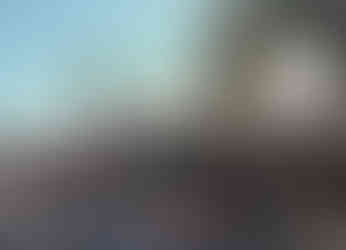


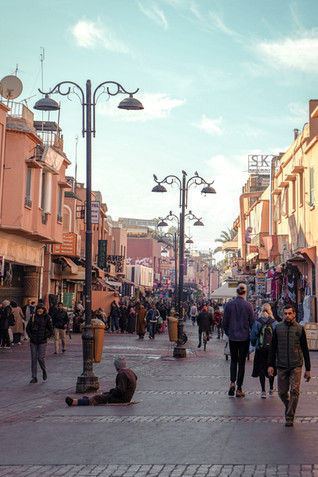






























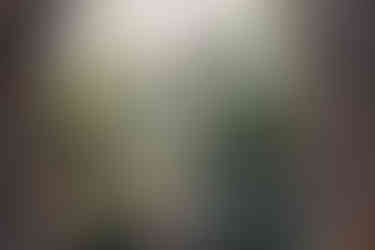



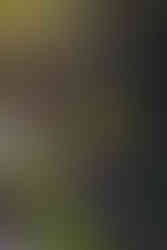








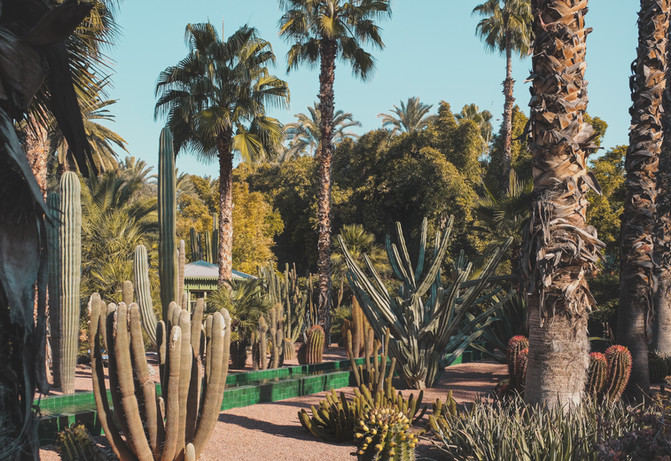





![[ a travel diary ] Alfama, Lisbon](https://static.wixstatic.com/media/8bacb6_13836a7515894f76a5d3a88da411ecb8~mv2.jpg/v1/fill/w_683,h_1024,al_c,q_85,enc_avif,quality_auto/8bacb6_13836a7515894f76a5d3a88da411ecb8~mv2.jpg)

Comments